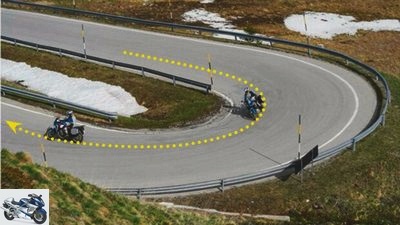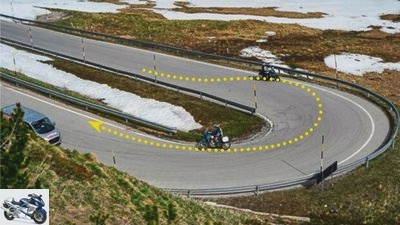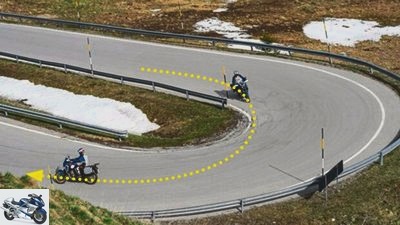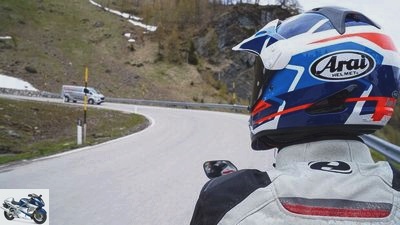Table of contents
- Motorcycling in the Dolomites Sweeping, eye technique, preparation
- Master sweeping safely
- Correct gaze guidance

Markus Jahn




14th pictures

Markus Jahn
1/14
The panoramas in the Dolomites are impressive.

Markus Jahn
2/14
But the curves are also challenging.

Markus Jahn
3/14
Especially for driving technique and concentration.

Zep Gori
4/14
Orange boxes shoot expensive photos. Such speed cameras are in almost every place and can be recognized early on. So keep to the speed limits in the localities (but also in other areas).

Zep Gori
5/14
Dark tunnels are particularly treacherous because the asphalt is often not visible in them, but wet and dirty. Caution, risk of slipping!

Zep Gori
6/14
Stones and rubble like to fall on the streets in the Dolomites. Even larger chunks lurk behind a curve from time to time. Open your eyes and be ready to dodge.

Tobias Beyl
7/14
Much slower cyclists are often out and about in groups and are wide like cars, which for their part do not always stay on their lane.

Zep Gori
8/14
Hairpin bends in the Dolomites are no ordinary bends. Especially to the right, some of them are so narrow that one is inclined to stop and maneuver. Here you can see the classic line in yellow.

Zep Gori
9/14
Here is the dangerous line. It inevitably results from a driving mistake: turning too early. At the exit of the curve you are often in oncoming traffic.

Zep Gori
10/14
The alternative line. Often a topic of conversation, in our opinion it is not a bad choice if there is ABSOLUTE certainty that there is no oncoming traffic and that nothing will rush past from behind.

Tobias Beyl
11/14
There are large numbers of coaches on the well-known Dolomite passes. Even motorcyclists have no passing on narrow streets.

Zep Gori
12/14
It gets wet and slippery when meltwater or rainwater makes its way across the street. Avoid large lean angles and braking.

Zep Gori
13/14
As you can see, you see nothing. What if the coach comes towards you now? There are many corners that cannot be seen here – reduce your speed and be ready to brake.

Markus Jahn
14/14
Marmots are well camouflaged and often cross our paths at medium heights. Keep a close eye on the roadside.
counselor
Driving experience & Driving tips
Motorcycling in the Dolomites
Motorcycling in the Dolomites
Sweeping, eye technique, preparation
It is not without reason that the largest motorcycle test in Europe – the MOTORRAD Alpen-Masters – takes place in the Dolomites over and over again. Motorcycle tours in the pale mountains are always something special. But they also harbor critical situations, so watch out.
Fabian Dresler
07/01/2021
Before it begins: Of course, your motorcycle should always be in a technically perfect condition. Defects in brakes, tires or chassis can quickly become life-threatening, no matter where you are. A tour in the Dolomites, however, needs to be better prepared than the home route circuit, because the material is particularly tough here. Before starting, you should definitely check your bike carefully and have parts replaced that could reach the wear limit during the trip. A replacement is usually only available after a while on the road. Absolute trust in the material also ensures the necessary serenity to be able to enjoy the Dolomites carefree.
Buy complete article

Driving in the Dolomites
Attention danger!
Pages) as PDF
€ 2.00
Buy now

Markus Jahn
Loading: Alone, as a couple, with or without a suitcase? The heavier we pack our bike, the deeper the rear sags. The consequences: indifferent driving behavior and low lean angle. In the best case, the level of the shock absorber can be raised again electronically or by handwheel; a hook wrench is often required for this. But it’s worth the effort.
Lever: Need for quick response in an emergency all levers can be easily reached. The incline should be adjusted via the respective clamps on the handlebars so that the hand and forearm form a line when the brake or clutch lever is pulled. When adjusting the reach, make sure that the brake lever can be reached with all fingers.
Tire: The legal minimum tread depth is 1.6 millimeters – but that’s not enough for the Alpine tour. Therefore, have almost worn or old tires changed before you start your journey. That You can find the tire’s date of birth on the flank. 0119 means for example “1st week 2019”. The appropriate air pressure should also be checked regularly.
Brake: Check discs and linings for wear and have them replaced if necessary. We recommend fresh brake fluid in any case. If it is too old, the braking power will drop sharply as the temperature rises. With the many long pass descents in the Dolomites with high loads on the brakes, that would be fatal.
Master sweeping safely
The classic line: Hairpin bends in the Dolomites are no ordinary bends. Especially to the right, some of them are so narrow that one is inclined to stop and maneuver. On the classic line, it is therefore difficult here and there to circle around the corners. The classic line means easy swinging at the entrance to the curve without getting into the opposite lane (this is difficult to avoid on narrow streets), in order to then turn in at the right moment and drive through the entire curve in the middle of your own half of the lane. Even if it is not the most dynamic way to negotiate a curve, the classic line always leaves room for internal and external corrections and keeps us away from oncoming traffic.

Zep Gori
The classic line.
The dangerous line: When entering the bend, we are usually not even aware of the fact that the line drawn on the left is dangerous. It inevitably results from a driving mistake: turning too early. As a result, we are still before the actual apex of the curve on the inner edge of the road and are carried out from there at moderate speed. At the exit of the curve we inevitably end up on the opposite lane. This line is seldom planned and is easy to avoid: Do not approach turns from the inside and deliberately turn in late. If that is impossible due to oncoming traffic, brake and roll slowly through this bend. There are plenty more to come.

Zep Gori
The dangerous line.

Zep Gori
The alternative line.
The alternative line: The principle of undercutting is still known from driving school. It is equally applicable to bends, which means: approach outside, turn in late and only be close to the inner edge of the road after the apex. In the case of tight bends to the right, we also recommend using the opposite lane – if possible – to swing back. Oncoming traffic can often be seen very early on serpentine roads, which is why the full width can be used when the road is clear. At the end of the curve, this results in reserves for inward correction at the same speed. Caution: If the view of the road behind the bend is poor, it is essential to stay in your own lane! Better safe than sorry.
Correct gaze guidance
“Do you look shit, do you drive shit”, is a well-known rule of eye guidance. In theory it is quite simple: Always look far ahead in the bends, aim at the exit of the bend as early as possible and keep your head slightly angled to your body for a straight horizon. These principles of gaze guidance apply in the Dolomites as well as on any country road and, as always, sound almost too simple – in the Alps, however, they require special concentration. Dirty spots on the asphalt and boulders on the edge of the road magically attract the eye. Uncertainty about the grip conditions also steers him down to just before the front wheel. Dangerous, because at a speed of only 50 km / h the response distance alone is 14 meters. So we have to resist the gaze magnet and keep our heads up to give us time for evasive maneuvers and braking maneuvers. So far, so special.

Zep Gori
In the Dolomites, breathtaking panoramas vie for attention. That is why it is important to have the right eye guidance and focus on the essentials.
In the Dolomites, however, we also encounter two types of curves in which the classic visual guidance reaches its limits: hairpin bends and secluded curves. Pointed can be taken literally, especially when turning to the right. In the case of serpentines, oncoming traffic is usually visible long in advance, because it comes a few meters higher or lower towards us before the hairpin bend. A sideways glance at the roadway “Behind” the bend should therefore be part of the curve preparation.
Classic visual guidance fails in secluded curves. Along many rock faces in the Dolomites, it is impossible to see the exit of the curve, the course of the curve and oncoming traffic are a surprise. In addition to slowing down the speed, it also helps to tilt the motorcycle and stretch your head outward as far as possible.
Related articles
-
Driving tips and advice on motorcycling
fact 26th pictures MOTORCYCLE 1/26 On the way on alpine passes? That’s how it works! MOTORCYCLE 2/26 Seductive winding curves with risk. The course of…
-
Report window lock in the Dolomites
jkuenstle.de 7th pictures www.j.kuenstle.de 1/7 Photo gallery: Window lock in the Dolomites. jkuenstle.de 2/7 Fixed on the road, hardly interested in the…
-
MOTORCYCLE tour tip – South Dolomites
Tour tips Exclusive motorcycle tours for children to follow Presented by Jorg Kunstle to travel MOTORCYCLE tour tip – South Dolomites MOTORCYCLE tour tip…
-
Tour tip: Motorcycling in the Black Forest
Iron ham 17th pictures Iron ham 1/17 Motorbike tour in the Black Forest: It cannot be emphasized enough: The attraction of riding a roller coaster on a…
-
MOTORCYCLE tour tip – Dolomites North
Tour tips Exclusive motorcycle tours for children to follow Presented by Jorg Kunstle to travel MOTORCYCLE tour tip – Dolomites North MOTORCYCLE tour tip…
-
Motorcycling under special conditions
Rosen Gargolov 12th pictures MOTORCYCLE 1/12 The measured values of a Honda CBR 600 F show how different road surfaces in the rain affect the braking…
-
MOTORCYCLE tour tip – Eastern Dolomites
Tour tips Exclusive motorcycle tours for children to follow Presented by Dirk Schafer to travel MOTORCYCLE tour tip – Eastern Dolomites MOTORCYCLE tour…
-
Motorbike trip in the Alps – alternative to the Dolomites
shepherd 29 pictures shepherd 1/29 Motorcycle trip: Alpine tour against the untravelled. shepherd 2/29 Motorcycle tour: Alpine tour against the…
-
Motorcycling on the Spanish Atlantic coast – Asturias
Daams 11 pictures Daams 1/11 Motorcycle tour through Spain. Explore Asturias by motorcycle. Image: Ensuring a good mood: Serpentine near Sotres. Daams…
-
archive to travel Motorcycling with a load Motorcycling with a load Transporting luggage on the motorcycle Those who go on vacation by motorcycle cannot…